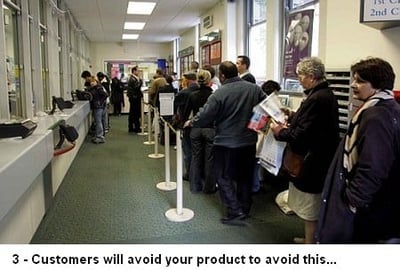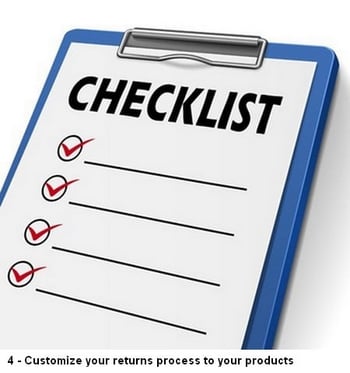The “Merry” part of the Christmas season can often be forgotten quickly when the first trucks show up at the receiving docks with mountains of returns. There is nothing worse as a retailer than experiencing the feeling that your products were “unwanted”, but if you do it right, returns processing can be a positive for your customers and your bottom line.
It’s Not the “Island of Misfit Toys”

No one likes a hangover after a big holiday event, but in the retail world, the weeks after the holiday season can often feel like one. Where just a few days earlier you were all smiles seeing those brand new cartons and shipping labels heading out the bay door by the thousands, but now you are watching carts full of damaged, recycled, thrice-used duct-taped boxes tumble onto your Receiving Dock. The scene of a busy packing line speedily assembling, packing and taping up your new cartons has now been replaced by the sound of cutters opening boxes and tape being ripped off, while piles of random packing from other Brands and newspapers grow all around. It’s not surprising if you see that unsightly corner of your warehouse as your own “Island of Misfit Toys”. But it doesn’t have to be that way.
If you are willing to set up your Product Returns process as a business opportunity, and not the “chore” it often seems to be, then you can turn it into something far more productive for your business. There are four core areas to plan for if you want to
- Your “Guarantee” and “Returns Policy”
- Budgeting for returns
- Returns shipping
- Returns processing
- Turning returns data into Sales

It Starts With Good Policy
Getting it right starts with getting your returns policy set up properly. If you were going to choose between two makers of the same item and one of them offered an unconditional guarantee and the other did not, which one would you order from? Which one would you order from if the one with the guarantee cost 3-5% more than the other?
A “guarantee” of performance, service, etc. is a strong signal to a prospective buyer that says “you have no risk working with us”. Taking away all the risk for the buyer is a great first step to making your returns processing easier. “But wouldn’t that increase the rate of returns?” you might ask. Well, perhaps, but businesses with strong guarantees find themselves forced to examine their entire business to ensure quality is maximized. Because if you don’t have the confidence in your product quality, then a real guarantee policy could get very expensive!
Of course, your guarantee should reflect the realities of your industry. But to start with, why not look at the best available option among your competitors and do a little better for your business?
Plan For Returns in Your Budget
This might seem obvious, but if you are not doing this already, you need to include “Returns” and “Replacement” line items in your P&L and budget accordingly. The comparison of the two numbers becomes a useful metric to indicate how your business is performing on both quality and loyalty. Returns will never be completely eliminated (unless you have a strict “No Returns” policy and are ignoring all the advice in this article – in which case you can stop reading now), but the budget line item can be used as a way to set goals to reduce them every year, or allow for increases expected brought about by new product launches, etc.
Customers who ”Return and Replace” are signaling that while the specific unit they received may be flawed in one way or another, their desire to own the product remains high. In an ideal world, while lowering returns to zero is actually NOT desirable, seeing close to 100% of them ask for a replacement can be. And if you haven't already, taking a step back and looking at this as a part of the bigger picture of "Reverse Logistics" is the real long-term approach to success.
Returns Shipping – Make it Easy

Have you ever been unhappy with a product and wanted to return it, but not unhappy enough to re-pack it and drag yourself down to a post office and pay the fees to ship it back? It’s a high probability that you didn’t order from that business again. Part of making your guarantee work effectively is to follow the promise all the way through: Take the risk out of the purchase process with the guarantee, but make the return process easy too. A guarantee without a simple way to return items won’t be seen as sincere or authentic.
Best practices out there should include:
- Pre-paid shipping labels sent with order
- Packaging that can be re-used for returns
- Clear and simple instructions, including a reminder of a “guarantee”
- Options for replacement or refund
This is all part of having a culture that welcomes complaints and not-always-positive feedback. A business’s biggest fear is the unhappy customer with no way to express their dissatisfaction. Because those we don’t hear from rarely come back. Take the complaints, and take the returns!
Return is a Little Receiving, a Little Q&A
Returns processing is both a receiving process and a Q&A process. Depending on what you sell, the process will differ of course. But to get to optimize the process for your business, you should be asking yourself the following questions:

- How often do they arrive every day?
- Can they be re-stocked and sold again?
- If yes, do they need new packaging?
- Is there any cleaning, maintenance or repair required?
- Can it all be onsite, or do they need to be transported to another facility?
- Do they get returned to a manufacturer you sell for?
- How fast does it take to process a return?
- How much training is required to do Q&A on returns?
Depending on how you answer these questions, your returns processing area will be set up differently. Like the rest of your facility, make sure you are taking advantage of all the technologies you have available to you. Barcodes to identify the order, product, customer, etc. are mandatory. Having something similar to a large picking cart with bins can be used to quickly move product AWAY from the returns area and back to the shelves or to another area used for re-packaging, repairs or maintenance, if necessary.
Finally, staffing the area requires different skills. Very often the same people who do the Q&A on your incoming shipments are best qualified to do returns as well, which can improve your staffing efficiencies in addition to your returns process.
Now Turn Your Returns Data Into Marketing And Sales Tools
Finally, by mastering your Returns processing and making it into a smooth guarantee promising machine, you can leverage what you’ve accomplished to improve on your Marketing and Sales.
By including a “Reasons for Return” checklist on your returns form, you automatically have a source of data that can lead to improvements in product, service and even marketing (are we messaging this correctly)?
And looking at insights like the demographics of who returned what, which products and price breaks are returned, or who tend to return items at a high rate, can all be used to improve both your marketing messaging and your sales pitches.










